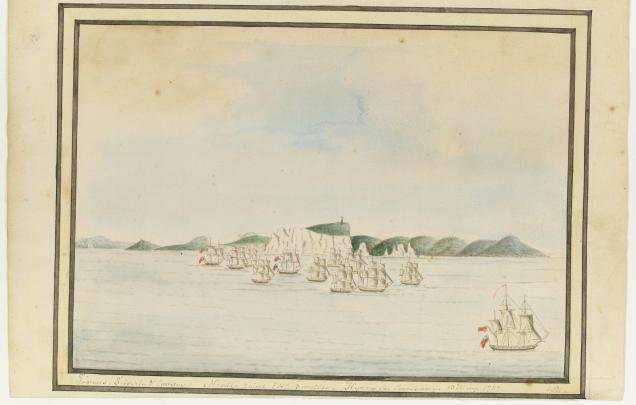Food They Brought With Them
Students investigate the food brought out on the First Fleet.
This is the student activity 1 of 8 of the Food of the colony learning activity.

Food they brought with them
The First Fleet carried food supplies from England, both for the journey and for the settlement. We know what some of the food stuffs were, but there is no comprehensive list of everything they had when they arrived in Sydney. Some items were also acquired on the way. The Fleet’s final stop before arriving at Botany Bay was at Cape Town at the Cape of Good Hope (now South Africa). There they replenished their stores of water and food for the rest of the journey to Botany Bay, and purchased additional supplies for the settlement’s future including plants, grain and farm animals.
When the First Fleet arrived in New South Wales there were many mouths to feed. Before departure Arthur Phillip had requested that the Fleet was supplied with enough food to last everybody for two years.
Read the list of some of the food unloaded in March 1788 that was recorded in the log book of the Lady Penrhyn. It could have come from England or been purchased along the way:
135 tierces of beef
165 tierces of pork
50 puncheons of bread
448 barrels of flour
116 casks of pease
110 firkins of butter
8 barrels of rice
[Note: No complete list of supplies brought out by the First Fleet exists.]
Some more interesting food items made their way to Sydney Cove/Warrane later on after the HMS Sirius went back to Cape Town for further urgent supplies in October 1788.
1 small cask of raisins
600 pounds of course sugar
100 pounds of Indian sago
6 pounds of spices
3 hogsheads of vinegar
Define the food-related words pease and sago.
Notice the different words or terms used for measurement. Define the meaning of these interesting measurement-related words: tierce, puncheon, barrel, cask, firkin, pound and hogshead. Convert these measurements to kilograms.
Answer these questions about both food lists:
- Out of the measured foods, which one is the largest amount?
- Which food items would you be most excited to eat?
- Can you guess who received the raisins, sugar, sago, spices and vinegar? [Answer in Additional Information.]
Governor Arthur Phillip had the food carefully measured out into rations so there would hopefully be enough to feed everyone in the colony for two years. All the men, from Governor Arthur Phillip to the convicts, were on the same rations. Women received 2/3 of those allocated to men, and children received less again.
Read this quote from Surgeon George Worgan in early 1788, that illustrated the amount of food the men were eating:
Convicts were to receive an equal share to men and officers—7 pounds of salt beef or four of pork, 3 pints of dried peas, 7 pounds of flour, 6 ounces of butter, half a pound of rice or, if it were not available, an extra pound of flour weekly.
Answer these questions:
- Was the pork or beef fresh?
- Why was the beef or pork salted?
- Can you think of something available today that might taste like convict-era salted meat? Maybe you could try some!
- Would you like to have this as your food every day for years?
Notice further different words used for measurement in George Worgan’s quote. Convert the pint and ounce measurements of the imperial system to the metric system. Using these measurements prepare a plate of food to match that one male convict might have received. Remember that George Worgan’s list was for a week of food. Can you calculate how much food was the daily allowance?
Compare this diet with the healthy food pyramid of today.
Answer these questions:
- What important food group on the pyramid is lacking for the convicts?
- Do you think that the diet of the convicts was adequate? Why or why not?
- If the food brought from England was still being served in rations in 1790, how old was it? Calculate the age of the food from the departure date of the First Fleet. It was prepared prior to that too!
Create an illustrated food pyramid using just the convict food.